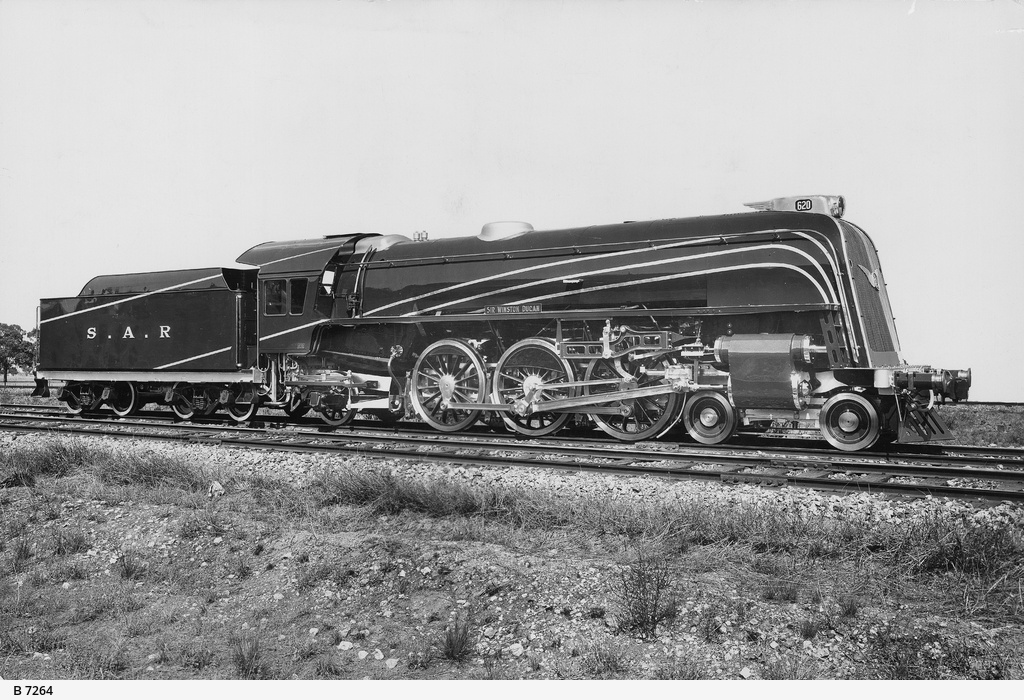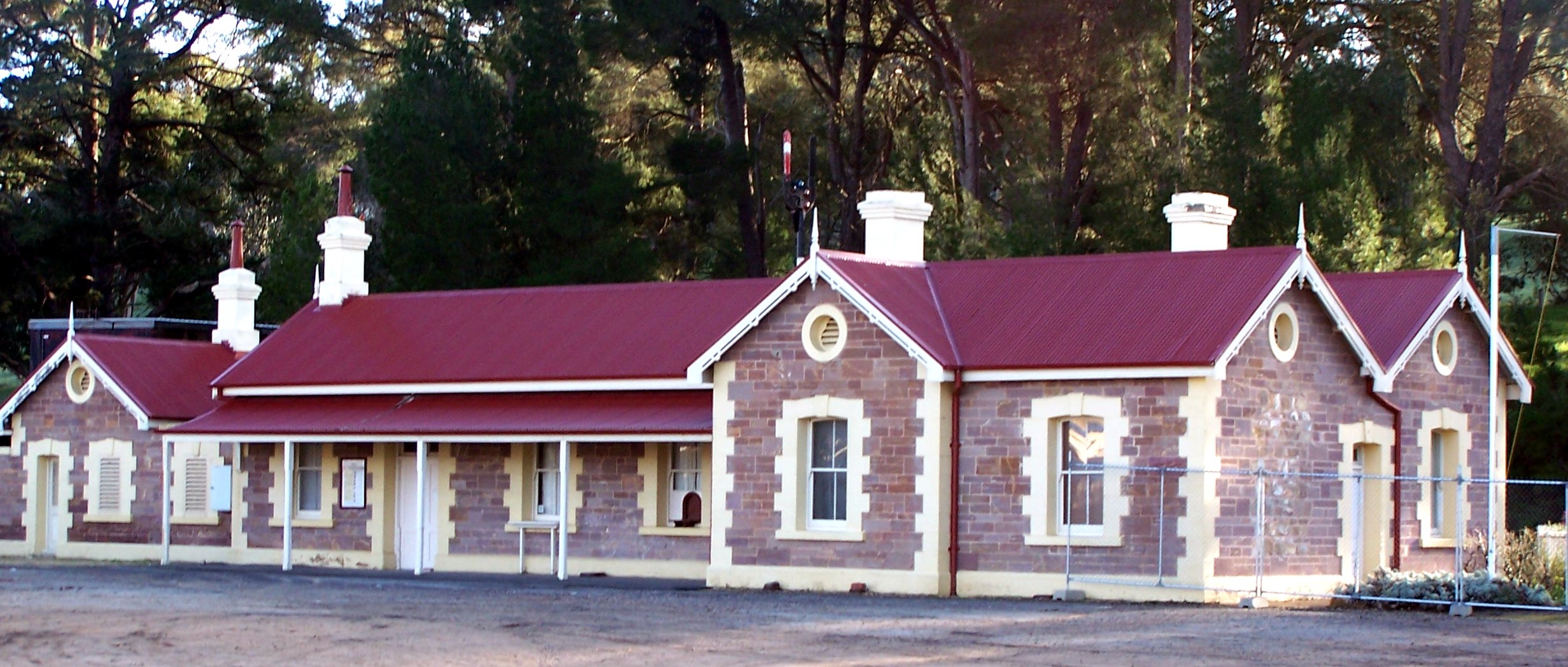|
Peterborough Railway Line
The Peterborough railway line was a railway line on the South Australian Railways network. It extended from a junction at Roseworthy on the Morgan railway line through Hamley Bridge, Riverton, initially to Tarlee, then extended in stages to Peterborough. History The Burra Burra railway was initially proposed as early as 1850, before any other railways north from Port Adelaide. Before anything was done about this, the Gawler railway line was built in 1857, and extended to Kapunda in 1860 (and eventually to Morgan in 1878, see Morgan railway line). The first stage of the broad gauge Burra line from a junction at Roseworthy to Forresters (now Tarlee) opened on 3 July 1869. It extended to Manoora on 21 February 1870, Burra on 29 August 1870, Hallett on 10 March 1878 and Terowie on 14 December 1880. Terowie was a break of gauge station with the line continuing north to Peterborough as a narrow gauge line, opening on 11 May 1881. On 12 January 1970, this 22.9-kilometre se ... [...More Info...] [...Related Items...] OR: [Wikipedia] [Google] [Baidu] |
Light River (South Australia)
The Light River (Kaurna: ''Yarralinka''), commonly called the River Light, is a seasonal and significant river in the Mid North region of the Australian state of South Australia named for early surveyor William Light. The River Light has given its name to the region of the state spanning the mid and lower part of the watercourse, which doesn't dry up over summer. The County of Light (cadastral land division) lies either side of the river for much of its course and gave rise to the name of three former local government bodies within the land division: the District Council of Light (1867–1892), the District Council of Light (1977–1996), and the present-day Light Regional Council, established in 1996. The locality of Lower Light spans the area where the river meets the coast in the Adelaide Plains and the Adelaide Plains Council was initially named Light from 1935 until 1937 after the river. Course and features The Light River rises on the northern slopes of the Mount Lofty ... [...More Info...] [...Related Items...] OR: [Wikipedia] [Google] [Baidu] |
One Rail Australia
One Rail Australia is an Australian rail freight operator company. Founded by Genesee & Wyoming Inc. in 1997 as Australian Southern Railroad, and later renamed Genesee & Wyoming Australia, it was renamed One Rail Australia in February 2020 after the company sold its remaining shareholding. In July 2022 it was purchased by Aurizon and the majority of One Rail's assets were transferred to that company; some remaining assets are set to be divested. Corporate history Genesee & Wyoming Inc. was one of several US regional railroad companies to take advantage of the privatisation of Australian rail freight operations in the 1990s. In 1997, its Australian company, Genesee & Wyoming Australia Pty Ltd, acquired the South Australian rail freight assets of Australian National from the Australian federal government, which included a 50-year lease on the South Australian network from the state government. Operations commenced in November 1997 under the "Australian Southern Railroad" ... [...More Info...] [...Related Items...] OR: [Wikipedia] [Google] [Baidu] |
South Australian Railways 620 Class
The South Australian Railways 620 class was a class of 4-6-2 steam locomotives operated by the South Australian Railways. History The completion of the South Australian Railway (SAR) broad gauge route between Adelaide and Port Pirie created a need for a fast, light passenger locomotive to haul this service, as well as other traffic on the lightly laid rail branch lines of the SAR. The specification included the ability to haul a train up a 1-in-45 (2.2%) grade at . Fred Shea, Chief Mechanical Engineer of the SAR designed a Pacific type. A notable feature of the design, unique to South Australian Railways, was the use of Baker valve gear in lieu of the more common Walschaerts valve gear. The first locomotive was completed at the Islington Railway Workshops in 1936, with the last completed in 1938. Class leader 620 was also notable for being Australia's first streamlined locomotive, the smokebox being covered with a chromed steel grille similar to those fitted to motor cars o ... [...More Info...] [...Related Items...] OR: [Wikipedia] [Google] [Baidu] |
SteamRanger
The SteamRanger Heritage Railway is a long broad gauge tourist railway, formerly the Victor Harbor railway line of the South Australian Railways (SAR). It is operated by the not-for-profit South Australian Division of the Australian Railway Historical Society. As the last operating non-suburban line of the former broad-gauge network, on which Australia's first public railway was opened, the line and its associated rail assets have high historical significance. History In the 1970s, the South Australian Division of the Australian Railway Historical Society established SteamRanger as a not-for-profit railway preservation offshoot to operate its train tours from Adelaide, mainly on rural lines throughout the state's broad gauge networks. SteamRanger opened their first purpose-built depot at Dry Creek railway station, north of Adelaide in 1980. From the mid-1980's, SteamRanger gradually took over the operation & maintenance of the Victor Harbor railway line. When plans were an ... [...More Info...] [...Related Items...] OR: [Wikipedia] [Google] [Baidu] |
Crystal Brook-Broken Hill Railway Line
A crystal or crystalline solid is a solid material whose constituents (such as atoms, molecules, or ions) are arranged in a highly ordered microscopic structure, forming a crystal lattice that extends in all directions. In addition, macroscopic single crystals are usually identifiable by their geometrical shape, consisting of flat faces with specific, characteristic orientations. The scientific study of crystals and crystal formation is known as crystallography. The process of crystal formation via mechanisms of crystal growth is called crystallization or solidification. The word ''crystal'' derives from the Ancient Greek word (), meaning both "ice" and "rock crystal", from (), "icy cold, frost". Examples of large crystals include snowflakes, diamonds, and table salt. Most inorganic solids are not crystals but polycrystals, i.e. many microscopic crystals fused together into a single solid. Polycrystals include most metals, rocks, ceramics, and ice. A third category of ... [...More Info...] [...Related Items...] OR: [Wikipedia] [Google] [Baidu] |
Track Gauge Conversion
Gauge conversion is the changing of one railway track gauge (the distance between the running rails) to another. Sleepers If tracks are converted to a narrower gauge, the existing sleepers (ties) may be used. However, replacement is required if the conversion is to a wider gauge. Some sleepers may be long enough to accommodate the fittings of both existing and alternative gauges. Wooden sleepers are suitable for conversion because they can be drilled for the repositioned rail spikes. Being difficult to drill, concrete sleepers are less suitable for conversion. Concrete sleepers may be cast with alternative gauge fittings in place, an example being those used during the conversion of the Melbourne–Adelaide railway from to . Steel sleepers may have alternative gauge fittings cast at production, may be drilled for new fittings or may be welded with new fittings. Structures Conversion from a narrow to a wider gauge may require enlargement of the structure gauge of the bridges, ... [...More Info...] [...Related Items...] OR: [Wikipedia] [Google] [Baidu] |
Break Of Gauge
With railways, a break of gauge occurs where a line of one track gauge (the distance between the rails, or between the wheels of trains designed to run on those rails) meets a line of a different gauge. Trains and rolling stock generally cannot run through without some form of conversion between gauges, leading to passengers having to change trains and freight requiring transloading or transshipping; this can add delays, costs, and inconvenience to travel on such a route. History Break of gauge was a common issue in the early days of railways, as standards had not yet been set and different organizations each used their own favored gauge on the lines they controlled—sometimes for mechanical and engineering reasons (optimizing for geography or particular types of load and rolling stock), and sometimes for commercial and competitive reasons (interoperability and non-interoperability within and between companies and alliances were often key strategic moves). Various solutions ... [...More Info...] [...Related Items...] OR: [Wikipedia] [Google] [Baidu] |
Evening Journal (Adelaide)
''The News'' was an afternoon daily tabloid newspaper in the city of Adelaide, South Australia, that had its origins in 1869, and finally ceased circulation in 1992. Through much of the 20th century, '' The Advertiser'' was Adelaide's morning broadsheet, ''The News'' the afternoon tabloid, with '' The Sunday Mail'' covering weekend sport, and ''Messenger Newspapers'' community news. Its former names were ''The Evening Journal'' (1869–1912) and ''The Journal'' (1912–1923), with the Saturday edition called ''The Saturday Journal'' until 1929. History ''The Evening Journal'' ''The News'' began as ''The Evening Journal'', witVol. I No. Iissued on 2 January 1869. From 11 September 1912Vol. XLVI No. 12,906 it was renamed ''The Journal.'' News Limited was established in 1923 by James Edward Davidson, when he purchased the Broken Hill ''Barrier Miner'' and the Port Pirie ''Recorder''. He then went on to purchase ''The Journal'' and Adelaide's weekly sports-focussed ''Mail'' i ... [...More Info...] [...Related Items...] OR: [Wikipedia] [Google] [Baidu] |
South Australian Register
''The Register'', originally the ''South Australian Gazette and Colonial Register'', and later ''South Australian Register,'' was South Australia's first newspaper. It was first published in London in June 1836, moved to Adelaide in 1837, and folded into '' The Advertiser'' almost a century later in February 1931. The newspaper was the sole primary source for almost all information about the settlement and early history of South Australia. It documented shipping schedules, legal history and court records at a time when official records were not kept. According to the National Library of Australia, its pages contain "one hundred years of births, deaths, marriages, crime, building history, the establishment of towns and businesses, political and social comment". All issues are freely available online, via Trove. History ''The Register'' was conceived by Robert Thomas, a law stationer, who had purchased for his family of land in the proposed South Australian province after be ... [...More Info...] [...Related Items...] OR: [Wikipedia] [Google] [Baidu] |
South Australian Chronicle And Weekly Mail
''The Chronicle'' was a South Australian weekly newspaper, printed from 1858 to 1975, which evolved through a series of titles. It was printed by the publishers of '' The Advertiser'', its content consisting largely of reprints of articles and Births, Marriages and Deaths columns from the parent newspaper. Its target demographic was country areas where mail delivery was infrequent, and businesses which serviced those areas. ''History'' ''South Australian Weekly Chronicle'' When ''The South Australian Advertiser'' was first published, on 12 July 1858, the editor and managing director John H. Barrow also announced the ''South Australian Weekly Chronicle'', which published on Saturdays. ''South Australian Chronicle and Weekly Mail'' On 4 January 1868, with the installation of a new steam press, the size of the paper doubled to four sheets, or sixteen pages and changed its banner to ''The South Australian Chronicle and Weekly Mail''. The editor at this time was William Hay, and i ... [...More Info...] [...Related Items...] OR: [Wikipedia] [Google] [Baidu] |
The South Australian Advertiser
''The Advertiser'' is a daily Tabloid (newspaper format), tabloid format newspaper based in the city of Adelaide, South Australia. First published as a broadsheet named ''The South Australian Advertiser'' on 12 July 1858,''The South Australian Advertiser'', published 1858–1889 National Library of Australia, digital newspaper library. it is currently a tabloid printed from Monday to Saturday. ''The Advertiser'' came under the ownership of Keith Murdoch in the 1950s, and the full ownership of Rupert Murdoch in 1987. It is a publication of Advertiser Newspapers Pty Ltd (ADV), a subsidiary of News Corp Australia, itself a subsidiary of News Corp. Through much of the 20th century, ''The Advertiser'' was Adelaide's morning broadsheet, ''The News (Adelaide), The News'' the afternoon tabloid, wit ... [...More Info...] [...Related Items...] OR: [Wikipedia] [Google] [Baidu] |




